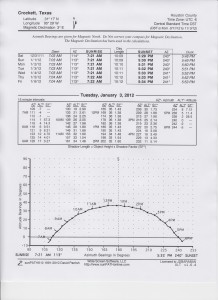Have you ever wished you were at a location at sunrise when instead, you were there at sunset? The wrong time at the right place?
Here’s the reason my work looks like it does:
For most of my career, I’ve known exactly where the sun would come up (to the degree), and exactly where it would set…anywhere in the world, on any date I choose. I also know exactly what time (to the minute) it will hit the horizon coming up and going down. I know how long ‘dawn’ is (the glow in the sky) prior to the actual sunrise, and how long ‘dusk’ is (the after glow in the sky) after the sunset.
I use a computer program called “Sunpath“. Whenever I know where I’m going to be shooting and when I’m going to be there, I put that information into it and it prints out a chart. From that, I know where I need to be to get the early morning light and late afternoon light.
Now, I use a “hand bearing compass” that you can get online. It’s called a Morin 2000, and it looks like a hockey puck. Inside it is a wheel with the 360 degrees marked on it. You can sight with it like you would a camera. When you go to the site, there’s a demonstration of how you use it.
I picked the date New Years Eve. 2011, and the location is for Crockett, Texas where I have my private “Stretching Your Frame of Mind” workshop for two couples.
Remember that these times will be when the sun actually hits the horizon. If you look at this chart, you’ll see when the first light of dawn occurs and how much time you have before the sun comes up. The same with how long you’ll have shooting in the after glow (dusk) until it’s dark. Look where it says dawn and dusk.
Now with this information, I can plan all my shots that I’ve scouted beforehand with my readings and compass. What I do is stand at a location I want to shoot, and look through my compass. The wheel inside floats in water, so what I do is point the compass to the appropriate degree from my readings (keeping it level with the ground).
I’ll know if a mountain or a building will block the sun right at sunrise, and I’ll know when the sun will break clear, and what time it will.
If you look at the bottom of the chart, you’ll see a graph. The graph charts the sun all day long. If you follow the curved line, you’ll notice a series of small black dots on it…that’s the sun. That’s the altitude of the sun in degrees. I have an instrument called an ‘Inclinometer’ . This device measures the altitude. So, together with the compass and the Inclinometer (you can get it in one instrument from Suunto called a tandem), I know where the sun is going to be all day long; from the time it hits the horizon on its way up to the time it hits the horizon on its way down.
This way, I can move to another location and return to that spot when the sun is clear of any obstacles…also, it sure is nice knowing exactly where the shadows will be all the time…24/7/365!!!!!! A lot of people always asks me how my color is so saturated, and the light always looks good…well now you realize that it’s not by chance. I always know where to stand, when to stand there and how long I have to stand there!
The Inclinometer is important for me to being precise, but the compass (Morin 2000) is all you would need if you think you can’t figure out the the altitude.
Finally, I’ve been told that the iPhone has an application that will give you the readings, but here’s the problem I have with that: First, it won’t tell you until your standing there. I’ll know a year in advance. Second, what happens when you don’t have service? I’m pretty sure you couldn’t get service in Big Bend National Park, with anyone!!! Of course, that’s subject to new technology.
I can get a GPS reading on my cell phone, but it’s not as accurate as looking through the Morin2000, and what happens if I don’t have a signal? Also there is a free download called a Photo Ephemeris that will also give you the information, but it’s very complicated and “above my pay grade”.
Having this kind of knowledge and tool is SOOOOOO powerful in creating photographs. I’m sure you can imagine!
With this knowledge, you’ll know if the glow behind a skyline, and it’s reflection on a body of water, will look the best at sunrise or sunset.
For people that have or will take a week workshop with me know, or will find out how ‘uncomplicated’ this really is. It may only seem difficult, but in reality it’s quite easy. You’ll get it in fifteen minutes on the first day.
The above photograph is an image I took while teaching my “Stretching Your Frame of Mind” workshop at the Maine Media Workshop. The class wanted to see how I go about setting up a photograph, from scouting locations with Sunpath and my compass, to gathering props, and a way to light him. By the way, this was one of my students we turned into a Lobster-Fisherman. At first, he didn’t want to put the trap over his shoulder because he said that they never did that.
I had to convince him that it was “taking license for the sake of art”!!!!!!
Based on my readings, I knew ahead of time that the sun was going to rise behind him and give me that glow.
Below is another example of having to know exactly where the sun was going to set.
What an advantage!
JoeB






